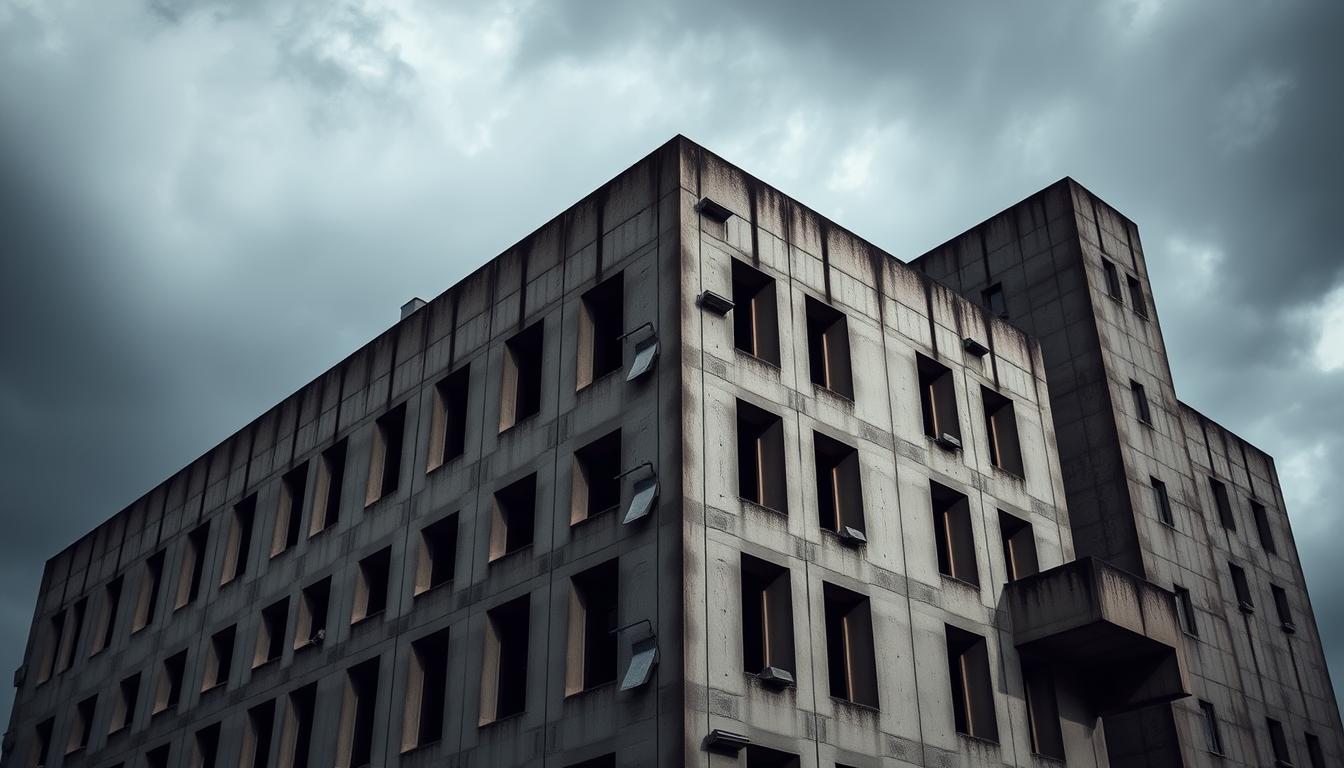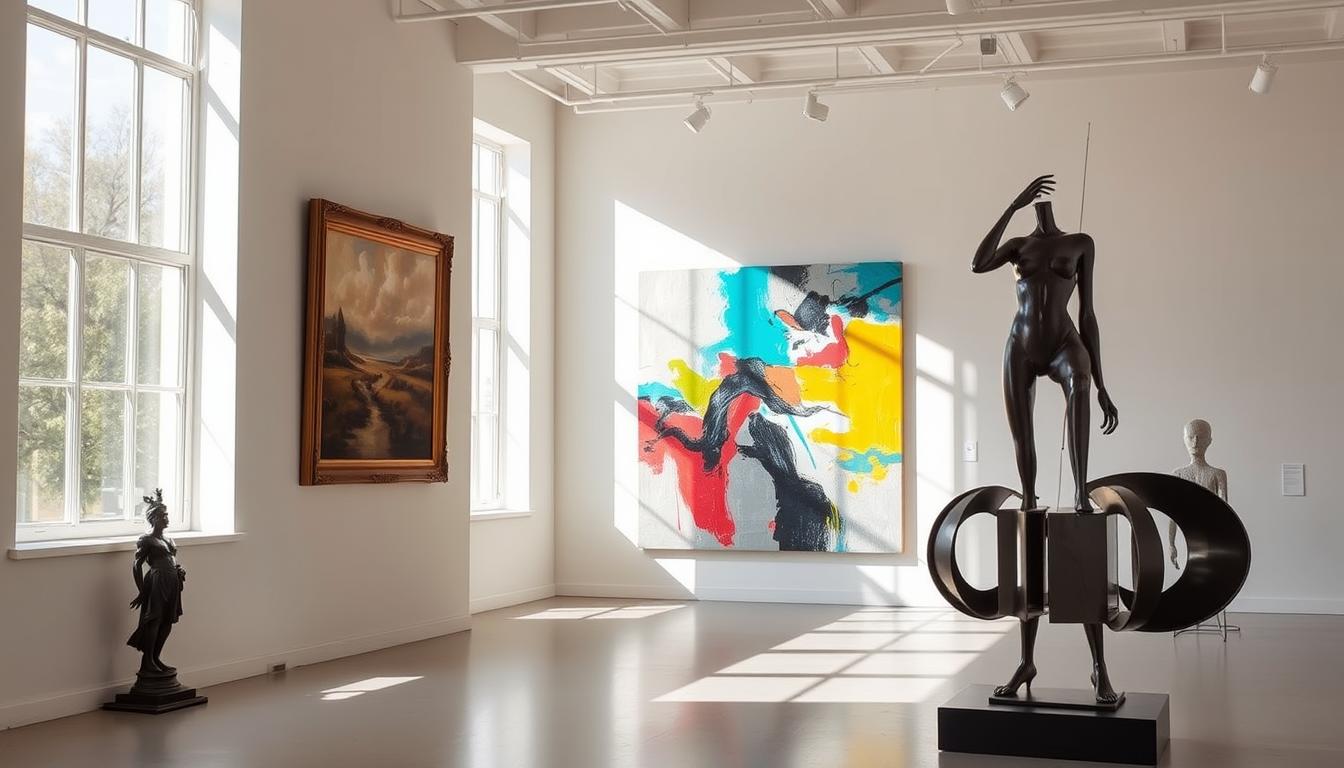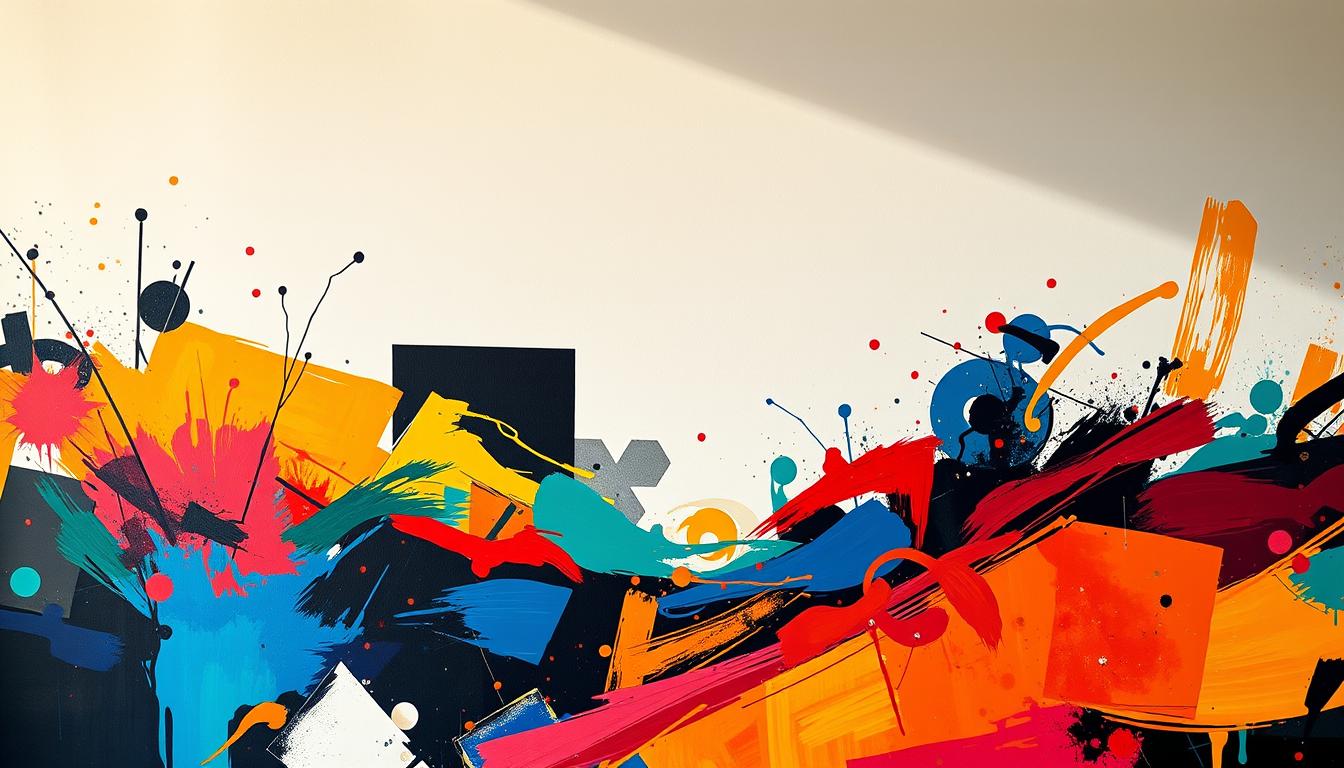Can a raw, concrete building feel honest and humane, or must it remain cold and forbidding? This guide starts with that question to spark curiosity and debate.

Brutalism grew from post‑war Britain in the 1950s, favoring exposed materials and clear structure over ornament. Buildings often show unpainted concrete, bold geometry, and heavy massing.
We’ll explain how the term links to Le Corbusier’s béton brut and how critics like Reyner Banham and the Smithsons shaped the movement. You’ll see why designers and viewers still argue about these powerful forms worldwide.
This introduction previews core traits, key icons such as Boston City Hall and the Barbican, and how the style compares to Modernism: both practical, but Brutalism is more tactile and direct. Read on for clear definitions, history, visual markers, and why these buildings remain so contested.
Key Takeaways
- Brutalism began in 1950s Britain and shows raw materials and visible structure.
- The name ties to béton brut and mid‑century critics who popularized the term.
- Common traits: exposed concrete, angular forms, monochrome palettes, and heavy massing.
- It differs from Modernism by emphasizing material honesty and tactile presence.
- Famous examples help explain both admiration and controversy worldwide.
What is a brutalist in art? Defining the style across architecture and visual culture
Designs that put construction and material honesty first form the backbone of this aesthetic. Practitioners prize legible plans, exposed joints, and surfaces left as found. That plainness lets users read how things work at a glance.
Core idea: creators favor utility over decoration. They show load-bearing parts, service routes, and raw finishes like concrete, brick, timber, steel, and glass.
Core idea: a utilitarian aesthetic that exposes materials and structure
Reyner Banham offered a practical checklist: formal legibility of plan, clear display of structure, and honest valuation of material. Use these three points to spot the approach in buildings or objects.
From buildings to graphic and web design: how the mindset travels
That same ethic moved into digital design. Think default fonts, raw HTML scaffolding, modular grids, and stark black‑and‑white pages. Sites such as Craigslist show how utility-first pages can feel refreshingly direct.
- Who practices it: architects and designers who prize clarity and function.
- Visual cues: angular geometries, monochrome palettes, visible services, and heavy massing.
- Legacy: Alison and Peter Smithson helped shape the movement’s moral claim that honesty equals good design.
Some find the look severe; others call it truthful. Later sections will unpack why audiences split over this way of making and reading the built world.
Origins and naming: from béton brut to “New Brutalism”
The name arrived by tracing materials and words used by architects and critics. Le Corbusier’s use of béton brut — raw concrete surfaces — provided the clearest source for the term. His Unité d’habitation (1952) showed communal housing, modular logic, and exposed concrete that many architects copied.
In Sweden, Hans Asplund called Villa Göth nybrutalism after its honest, “as found” detailing: exposed I‑beams, visible brick, and board‑marked concrete. That example helped push material‑first thinking across Europe.
The Smithsons then popularized the phrase in Britain. Alison and Peter Smithson published "new brutalism" and built key works like Hunstanton School and Sugden House that openly displayed structure and services.
Reyner Banham tied these ideas together in his 1955 essay, framing the movement as both an ethic and an aesthetic: legible plans, materials left as found, and clear structure. In short, it’s called Brutalist not for ferocity but for béton and a push toward truthful design amid post‑war housing needs.
| Origin | Key example | Contribution |
|---|---|---|
| Le Corbusier | Unité d’habitation | Popularized béton brut and modular housing |
| Hans Asplund | Villa Göth | Coined nybrutalism; “as found” detailing |
| Smithsons | Hunstanton School, Sugden House | Named and exemplified New Brutalism in UK |
| Reyner Banham | The New Brutalism (essay) | Codified the ethic and aesthetic |
Key characteristics: materials, forms, and the ethic of honesty
Look closely and you’ll see how choices about material and form encode an ethical stance on making buildings.
Material palette: Exposed, unpainted concrete and brick dominate, with steel, timber, and glass used without cosmetic finishes. Surfaces often show board‑formed textures that celebrate construction rather than hide it.
Banham’s criteria in action: Plans read clearly from façades, structural systems remain legible, and every material is valued as found — not dressed up to impress.
Forms and elements: Massive volumes, angular geometries, and modular repetition make circulation and program easy to decode. Projecting masses mark civic rooms, as at Boston City Hall, while Hunstanton School leaves services visible.
Social design moves: "Streets in the sky" separated pedestrians from traffic in many housing projects, linking safety and social aims to the architecture.
| Characteristic | What to look for | Example |
|---|---|---|
| Material honesty | Concrete, brick, steel, timber left as built | Board‑formed béton brut surfaces |
| Formal legibility | Plans and rooms read from the outside | Boston City Hall projections |
| Visible services | Utility routes and tanks displayed | Hunstanton School water tank |
| Modular repetition | Repeated bays and volumes | Housing blocks with stacked units |
In short: the style trusts users to read structure and program. This honest way of design sets Brutalism apart and prepares us to compare it with Modernism next.
Modernism vs. Brutalism: how the movements differ
After WWII, two allied design currents split over how plainly buildings should show structure and material.
Shared roots: both favor function, rational planning, and clear program. They came from the same modern impulse in architecture and sought practical solutions for rebuilding.
Shared roots in functionality, divergent attitudes toward expression
Modernism tends toward refined minimalism, smooth surfaces, and visual lightness. It often aims for a universal, polished aesthetic.
Modernist refinement vs. Brutalist mass, texture, and exposure
Brutalism reacts by exposing concrete, structure, and services. The result is heavier, more tactile, and openly legible.
"Brutalism was an ethic as much as an appearance—honesty about materials and social purpose."
- Time: Brutalism followed Modernism and pushed back against nostalgic revival.
- Social aim: Brutalism often served housing and institutions under tight budgets.
- Quick recall: Modernism = refined minimalism; Brutalism = material honesty and legible structure.
| Feature | Modernism | Brutalism |
|---|---|---|
| Surface | Polished, smooth | Raw, textured concrete |
| Expression | Subtle, refined | Exposed structure |
| Social role | Universal design ideals | Housing, civic pragmatism |
| Ethic | Formal clarity | Material honesty (Smithsons) |
Where Brutalism spread: institutions, housing, and icons around the world
From London to Warsaw, raw concrete shaped bold public places across the globe. Public clients needed durable, fast solutions after the war, so many city and university projects favored heavy, legible forms.
United Kingdom highlights
Barbican Centre and the Royal National Theatre show massive urban ensembles and layered terraces. Neave Brown’s Alexandra Road offers housing that balances community planning with clear circulation.
United States examples
Boston City Hall stands as a bold civic landmark. Marcel Breuer’s Madison Avenue building in New York reads like an “inverted ziggurat,” making concrete mass visually compelling. The J. Edgar Hoover Building remains a high‑profile government example.
Eastern Europe and public works
Socialist‑era housing and civic projects across the region used similar concrete forms to meet egalitarian goals. Universities, libraries, and courts adopted the style for its economy and robustness.
"Robust materials and clear circulation made these buildings practical for large public programs."
| Region | Notable example | Why chosen |
|---|---|---|
| UK | Barbican Centre | Urban ensemble; cultural complex |
| US | Boston City Hall | Civic presence; legible program |
| Eastern Europe | Housing blocks | Economical mass housing; social aims |
Quick cues: look for terraced forms, projecting volumes, sculptural stair towers, and exposed concrete paired with steel or glass. For further reading on this global spread, see Brutalist architecture.
Why is Brutalism so controversial?
Public reaction often splits sharply when massive concrete forms dominate a skyline. Some critics call such buildings cold or oppressive, while other observers praise their candid honesty and social intent.

Late‑20th‑century backlash grew as weathering, deferred maintenance, and economic decline left many projects looking tired. That visual decay linked the movement to urban blight and, at times, to totalitarian aesthetics.
Power and perception
Government use of tough, monolithic forms — courts, ministries, city hall projects — amplified impressions of impersonal authority. Media and film then used these backdrops to signal dystopia or bureaucracy.
Preservation versus demolition
Demolition campaigns have erased some landmarks, while preservationists mount fierce defenses. Tastes shift: what once seemed outmoded now attracts protection and new admiration.
"Architecture that foregrounds mass and material rarely sits in a neutral middle ground."
| Factor | Critical view | Supportive view |
|---|---|---|
| Aesthetic | Cold, monstrous | Honest, egalitarian |
| Policy | 2020 U.S. order favored classical styles | Order reversed in 2021; debate continues |
| Media | NPR: public disdain for FBI HQ | New York Times essay (2024) praised social ideals |
Controversy endures because the movement exposes structure and material with little camouflage. That transparency forces clear judgments about design, power, and the future of housing and public space.
Architects, projects, and vocabulary every enthusiast should know
Learn the people, places, and terms that help you read concrete and steel as clear signals.
Key figures: Alison and Peter Smithson gave the movement its moral claim. Le Corbusier set precedents with béton brut. Marcel Breuer showed sculptural, civic massing. Reyner Banham named and framed the discourse.
Signature projects to recognize
Robin Hood Gardens stands as the Smithsons’ contentious social experiment. Boston City Hall is a civic example with bold projecting rooms. The Barbican offers layered, urban massing. Robarts Library reads like a fortress; each is useful as a photo reference.
Terms that decode the look
- bétón brut / béton: raw concrete surfaces and board marks.
- “as found”: materials left without cosmetic finishing.
- service expression: visible utilities and ducts as design signals.
- Modular repetition, massing, ziggurat steps, and extrusions.
"Language from critics helped turn material choices into a public debate."
| Who | Example project | Notable elements |
|---|---|---|
| Alison and Peter Smithson | Robin Hood Gardens | Social plan, visible services, modular bays |
| Le Corbusier | Unité d’habitation | bétón brut, communal modules |
| Marcel Breuer | Madison Ave building | Sculptural massing, inverted ziggurat |
| Reyner Banham | The New Brutalism (essay) | Critical framing and vocabulary |
Brutalism today: contemporary art, design, and media
Brutalism keeps circulating through today’s creative fields, not simply as nostalgia but as an active set of choices about clarity and economy.
Digital and graphic design: Many designers strip interfaces to essentials. They use default type, stark monochrome palettes, and tight modular grids to show hierarchy plainly. Sites cataloging these trends, like brutalistwebsites.com, helped spread the look among web and product teams.

Film and culture: The 2024 film The Brutalist brought renewed attention to this movement. Critics and viewers linked the protagonist’s concrete projects to real midcentury architects, sparking debates across film coverage and New York cultural pages. Movies often frame such buildings as characters that shape mood and meaning.
Practical appeal: Architects and artists return to the movement’s principles for good reasons: honest materials, simple forms, and cost-aware construction still answer pressing needs around the world. The style’s elements—oversized type, unstyled layouts, and clear grids—help makers communicate function with unusual directness.
"The language of raw form and visible structure keeps the conversation about design accountability alive."
| Field | How the ethic appears | Why it matters today |
|---|---|---|
| Web & Graphic design | Default fonts, monochrome, modular grids | Faster builds, clearer content hierarchy |
| Film & Media | Concrete buildings as narrative devices | Rekindles public debate; broadens audience |
| Architecture | Material honesty, cost-aware forms | Practical, durable public projects |
Conclusion
This conclusion pulls together why raw material honesty changed midcentury practice and still sparks debate today.
Brutalism began as an ethic that foregrounded materials and legible structures. The name ties to béton brut and the New Brutalism movement, which pushed for truthfulness over cosmetic finish.
Compared with Modernism, this architectural style favors mass, texture, and exposed systems rather than polished refinement. Designers use these choices to reveal how a building works.
Controversy stays alive because some viewers find concrete forbidding while others praise candid clarity and social intent. Preservation efforts and renewed interest show these buildings shape how we value public life around the world over time.
Enhance Your Space with Unique Modern Masterpieces
Are you inspired by the innovative mediums and conceptual depth highlighted in our exploration of contemporary art? You’re not alone! Today’s art enthusiasts are seeking cultural relevance and emotional connections in their artwork. However, finding pieces that resonate with modern themes and fit your unique style can be a challenge. That’s where we come in!
At Rossetti Art, we specialize in canvas prints, original paintings, and modern sculptures that celebrate the spirit of now. Each piece created by Chiara Rossetti brings a personal touch that connects deeply with current social narratives—just like the modern masterpieces discussed in the article. Don’t miss out on the chance to elevate your home decor with breathtaking artwork that speaks to your values and aesthetic. Explore our collection today and find your perfect piece! Act now, and transform your space into a gallery of inspiration!
FAQ
What defines Brutalism as an architectural style?
Brutalism emphasizes honesty of materials and structure. Buildings often show raw concrete, exposed steel, and visible service runs. Forms read clearly, with modular repetition and bold massing instead of decorative cladding.
How did béton brut influence the movement?
Le Corbusier’s use of béton brut—board-marked, textured concrete—set a template. The Unité d’Habitation demonstrated how rugged concrete could shape large-scale housing and public projects, inspiring architects across Europe and beyond.
Who popularized the term “New Brutalism”?
Alison and Peter Smithson used the term to describe a social, utilitarian approach that celebrated raw materials and clear function. Critic Reyner Banham later articulated its aesthetic and ethics in essays that helped spread the idea.
Which materials and design elements are characteristic?
Expect concrete, brick, steel, timber, and glass left “as found.” Architectural elements include exposed structural bays, pronounced massing, angular geometry, and façades that reveal stair cores, balconies, and utilities.
How does Brutalism differ from Modernism?
Both share functional roots, but Modernism often pursues refinement and sleek surfaces. Brutalism prioritizes texture, scale, and material truth, favoring rugged expression over elegant minimalism.
Where did Brutalist buildings appear most often?
The style appeared widely in public institutions: civic centers, universities, libraries, and social housing. Notable examples include the Barbican and National Theatre in London, Boston City Hall, and various Eastern European civic housing projects.
Why do opinions about Brutalism divide people?
The aesthetic can feel severe or cold to some, while others find it honest and powerful. Associations with postwar reconstruction and authoritarian architecture fueled backlash, even as preservationists and new fans argue for its cultural value.
Which architects and projects are essential to know?
Key figures include Le Corbusier, Alison and Peter Smithson, Marcel Breuer, and architects featured by Reyner Banham. Landmark projects include Robin Hood Gardens, the Barbican Centre, Boston City Hall, and Robarts Library in Toronto.
How does Brutalist thinking influence contemporary design?
The mentality appears in digital and graphic work: modular grids, stark palettes, and utilitarian typography. Architects reuse concrete’s directness for new cultural centers, housing, and adaptive reuse projects.
Can Brutalist buildings be preserved or adapted?
Yes. Many communities mount preservation campaigns to save iconic structures. Adaptive reuse often softens interiors or adds glazing while retaining the exterior’s material character and structural legibility.
Where can I read more in-depth analysis?
Look to books and essays by Reyner Banham, monographs on Le Corbusier and the Smithsons, and features in publications like The New York Times for historical context and contemporary debate.






Leave a comment
This site is protected by hCaptcha and the hCaptcha Privacy Policy and Terms of Service apply.